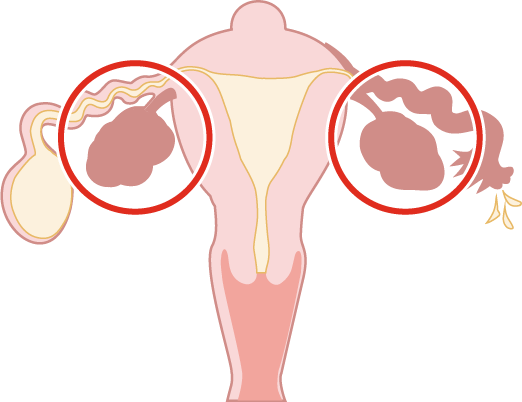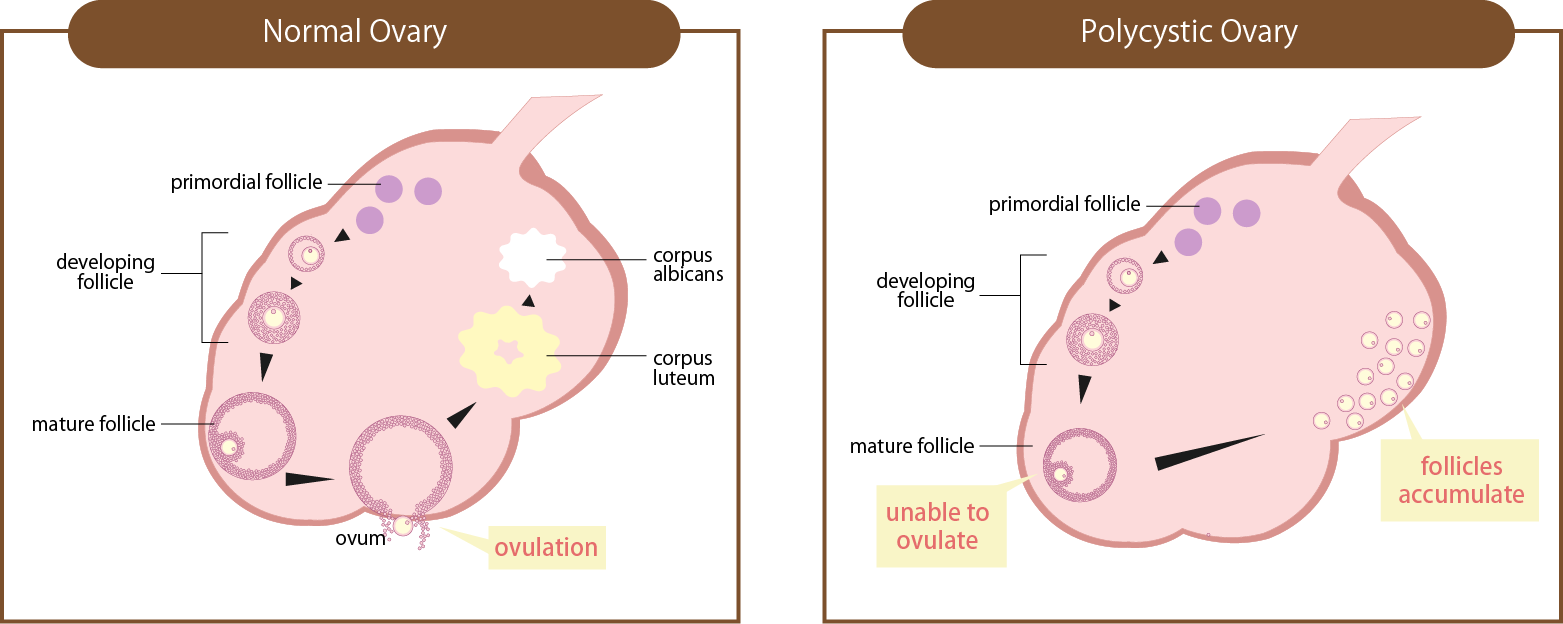
The ovaries are organs located deep within the abdomen (pelvis), on both sides of the uterus, and they contain primitive follicles (the original cells that develop into eggs).
During adolescence, mature follicles are released from the ovaries, and menstruation occurs due to the hormones (estrogen and progesterone) secreted by the ovaries.
The ovaries, which are important organs containing reproductive cells, are said to be prone to tumor development.
However, ovarian tumors often have minimal initial symptoms, and by the time they are detected, they have usually progressed significantly.
If you experience symptoms such as abdominal swelling or frequent urination, it is important to seek medical attention promptly.

Various types of cysts and tumors can develop in the ovaries.
They can be easily detected through outpatient ultrasound examinations.
However, since they often do not cause significant symptoms, some individuals may not seek medical attention until the cysts have grown larger.
When the cysts grow larger, they can hinder pregnancy and childbirth, twist (a condition called ovarian torsion), or even become malignant.
Therefore, in most cases, surgery is necessary as a primary treatment option.
| Name of Condition | Main Symptoms |
|---|---|
| Serous Cystadenoma | A condition in which a thin, smooth-walled tumor contains a low-viscosity, pale yellow, transparent fluid known as serous fluid, which is secreted from the ovaries. It is typically a unilocular cyst. Generally, it does not have the potential to become malignant. |
| Mucinous Cystadenoma | A condition in which a tumor accumulates a high-viscosity, gelatinous fluid. It often presents as a multilocular cyst with internal compartments separated by walls. It can be challenging to differentiate from malignant tumors. It is commonly seen in postmenopausal women. |
| Dermoid Cyst/Teratoma | A tumor that contains dividing mature cells and masses with components in various stages of maturation, such as hair, teeth, fat, skin tissues, and bones. It frequently occurs in individuals in their 20s to 30s, and in such cases, it is almost never cancerous. In rare cases, it can become cancerous in older individuals, such as postmenopausal women. |
| Endometrioma/Chocolate Cyst of the Ovary | One of the symptoms of endometriosis. It involves the proliferation of endometrial tissue, found only within the uterus, in various parts of the ovary. The endometrial tissue and blood undergo discoloration, resembling chocolate. It is commonly observed in women in their 30s to 40s, and beyond the age of 40, it can occasionally develop into cancer. |
However, on the other hand, the ovaries may temporarily swell with the menstrual cycle.
If it is a condition where the ovaries are simply filled with fluid, it will naturally disappear within a few months and require observation.
Surgery options such as open surgery, laparoscopic surgery, and ultrasound-guided aspiration are chosen based on the condition of ovarian cysts, tumors, and various examinations.
By suppressing the secretion of ovarian hormones through nasal sprays or injections, it is possible to prevent them from growing larger or even reduce their size.
As symptomatic treatment, low-dose birth control pills can also be used to control menstrual pain and excessive bleeding.
If symptoms are present, if the cyst is too large, or if it is causing infertility, surgery will be necessary.
There are various surgical methods available.
While there is an option to remove the entire uterus, our clinic specializes in preserving fertility and generally performs surgery to remove only uterine fibroids.
In addition to conventional open surgery, there are also laparoscopic (laparoscope-guided) procedures and hysteroscopic resection, which is a surgical method performed under the guidance of a uterine scope.
Each method has its advantages and disadvantages, and whether or not it can be performed depends on individual cases.
The approach will also differ for unmarried individuals, those with specific plans for pregnancy, individuals undergoing infertility treatment, and those nearing menopause.
Therefore, we provide counseling to propose the most suitable method based on each individual's condition.
PCOS is a condition where the hormonal balance is disrupted, causing the ovaries to become enlarged and the follicles to become hardened, leading to difficulties in ovulation.
It is a common cause of ovulation disorders and amenorrhea (absence of menstruation).
For individuals experiencing infertility, treatment is typically done using oral medication or injectable ovulation-inducing drugs. However, since PCOS often results in the development of multiple follicles, directly inducing ovulation may lead to multiple pregnancies, making in vitro fertilization (IVF) necessary.
Alternatively, there is a surgical procedure called laparoscopic ovarian drilling, where small holes are made on the surface of the ovaries using a laparoscope.
This surgery can stimulate natural ovulation for about six months.
On the other hand, for individuals who do not have plans for pregnancy, we recommend using low-dose birth control pills or other hormonal contraceptives to manage the progression of the disease and ensure it does not interfere with future pregnancies.
Additionally, PCOS is often associated with obesity, acne, and excess hair growth.
When these symptoms cannot be effectively controlled with low-dose birth control pills, we may recommend weight loss for obesity, chemical peels for acne, and laser hair removal for excess hair, as part of the treatment plan.

There are two main treatment options for endometriosis: medical therapy and surgical therapy.
In medical therapy, medications such as nasal sprays or injections can be used to suppress menstruation and shrink endometrial lesions.
Additionally, low-dose birth control pills may be prescribed to alleviate symptoms and slow down the progression of the condition, particularly in milder cases.
Surgical options include open surgery and laparoscopic surgery.
Currently, laparoscopic surgery is more commonly performed, where endometrial lesions are cauterized using techniques like electrocautery.
For cases of chocolate cysts, there is also a method called alcohol sclerotherapy, where the blood inside the cyst is aspirated using a needle under ultrasound guidance, and alcohol is injected to destroy the cyst wall cells.
In cases of adenomyosis, it can be challenging to physically remove the lesions since the affected and normal areas are mixed together.
Although surgery may be performed for localized adenomyosis, it is not yet a well-established procedure.
Therefore, medical therapy is generally the preferred approach.
In cases of infertility, a method called the "ultralong" protocol can be employed, where menstruation is suppressed for an extended period, followed by in vitro fertilization (IVF).
This method has been successful in achieving successful pregnancies for individuals with severe adenomyosis who experience recurrent miscarriages.
The medication used for treatment is a low-dose birth control pill covered by insurance.
If you are receiving ongoing treatment, it is necessary to submit the following documents at each visit.
It would be helpful if you could download (print) the documents below, fill them out in advance, and bring them with you for a smoother process.
| Clinic Information | Oak Clinic, Sumiyoshi Oak Clinic, Umeda |
*Low-Dose Birth Control Pill Questionnaire Check Sheet Information for Patients Requesting Low-Dose Birth Control Pills (Sumiyoshi/Umeda) |
|---|